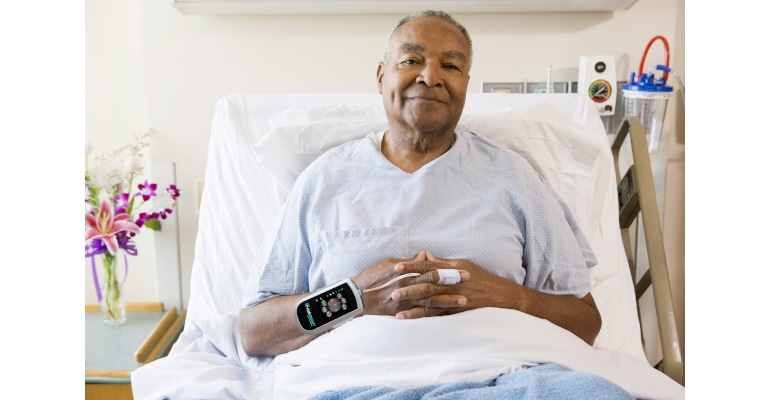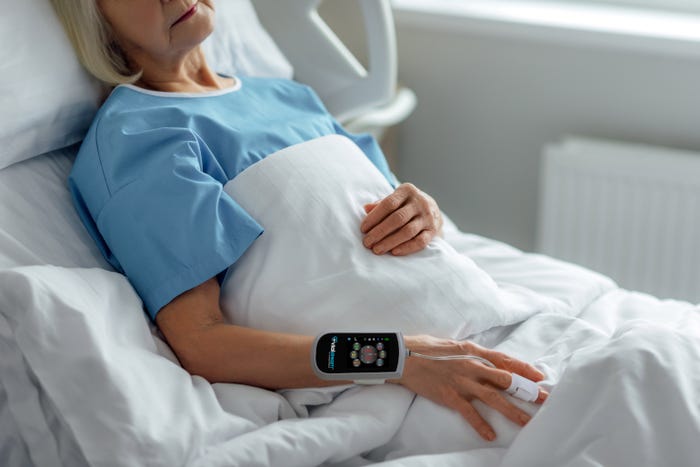Caretaker Medical’s VitalStream is an FDA-cleared wireless, wearable device that measures continuous beat-by-beat blood pressure, cardiac output, and hemodynamics.
May 25, 2022

“If you think about blood pressure and hemodynamic things like cardiac output and stroke volume, they're typically measured one of two ways,” said Jeff Pompeo, CEO, Caretaker Medical, in an interview with Design News.
“Either intermittent spot checks, [such as] the upper arm cuff that inflates every 20 or 30 minutes, and it gives you a single-point-in-time look at your blood pressure; or with invasive arterial catheters that deliver continuous
measurements.”
However, he said, blood pressure changes constantly and arm cuffs only capture a single moment in time. “If you're in critical care or if you're in the ICU or surgery, or if you're in a pain clinic or a dialysis clinic, where there's
lots of hemodynamic change going on with your cardiovascular system, then these blind spots between intermittent readings are really problematic,” Pompeo explained. “It's like if you were flying an airplane and your
altimeter only checked your altitude every five minutes.”
The current gold standard way to continuously measure hemodynamics entails using a needle to insert a catheter into a patient’s artery, and then is connected to a complicated monitor requiring manual calibration. This process is not only invasive, but can be painful, there is a risk of infection, and it can take up to a half hour to start working.
Caretaker Medical’s VitalStream continuous beat-by-beat wireless, noninvasive hemodynamics monitor overcomes the drawbacks of both these methods. “We provide continuous hemodynamic measurements with this simple little finger sensor and this wearable, and we do it completely wirelessly,” Pompeo noted. “So instead of having a patient tethered to a bed and a pole, we can do it while patients are ambulatory, as they’re mobile, and all the data can go to the Cloud for tracking them remotely after patient discharge.”
VitalStream also eliminates the blind spots between what is otherwise an intermittent spot-check reading, Pompeo said. “So now you have this this full, continuous digital record of your hemodynamic health to make better
treatment decisions and to see problems earlier clinicians can take life-saving actions earlier.”
The VitalStream monitor consists of a finger sensor, which is attached to a wrist-worn display. It uses pulse decomposition analysis (PDA) technology, which is the company’s patented pulse contour analysis approach to
quantify hemodynamic measurements.
“Every time the heart injects blood into the aorta, there's a reflective pressure wave that returns from specific reflection points in the arterial tree, and that's where the magic happens,” Pompeo said. “Our finger sensor is listening for the reflective waveform that return back up the aortic tree, and then the PDA algorithms break that waveform apart into its three constituent parts—P1, P2, and P3 to derive blood pressure and hemodynamic
measurements with each heartbeat.”
VitalStream uses Bluetooth or Wi-Fi to send data to a tablet app, which in most cases is being watched by a clinician outside the room, Pompeo said. Data can also be uploaded to the company’s secure Cloud portal to
monitor patients remotely.

VitalStream is commercially available and is being used by clinical customers that run the gamut from hospitals and critical care to infusion centers, oncology, sleep disorder labs, pain management clinics, and clinical trials for pharmaceutical companies, Pompeo said.
“We think the future of blood pressure is going to move from a spot-check ‘single moment in time’ number, to a continuous stream of data and waveforms, similar to an ECG,” Pompeo concluded. “Instead of saying, ‘give me a blood pressure reading,’ clinicians are going to say, ‘give me two minutes of continuous blood pressure so that I can really assess the hemodynamics health of this patient.’ ”
About the Author(s)
You May Also Like



